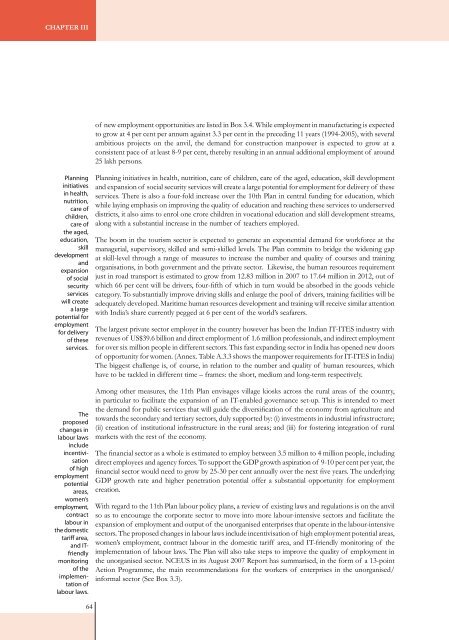SOIL Report 2008 - ACCESS Development Services
SOIL Report 2008 - ACCESS Development Services
SOIL Report 2008 - ACCESS Development Services
Create successful ePaper yourself
Turn your PDF publications into a flip-book with our unique Google optimized e-Paper software.
Chapter IIIof new employment opportunities are listed in Box 3.4. While employment in manufacturing is expectedto grow at 4 per cent per annum against 3.3 per cent in the preceding 11 years (1994-2005), with severalambitious projects on the anvil, the demand for construction manpower is expected to grow at aconsistent pace of at least 8-9 per cent, thereby resulting in an annual additional employment of around25 lakh persons.64Planninginitiativesin health,nutrition,care ofchildren,care ofthe aged,education,skilldevelopmentandexpansionof socialsecurityserviceswill createa largepotential foremploymentfor deliveryof theseservices.Theproposedchanges inlabour lawsincludeincentivisationof highemploymentpotentialareas,women’semployment,contractlabour inthe domestictariff area,and ITfriendlymonitoringof theimplementationoflabour laws.Planning initiatives in health, nutrition, care of children, care of the aged, education, skill developmentand expansion of social security services will create a large potential for employment for delivery of theseservices. There is also a four-fold increase over the 10th Plan in central funding for education, whichwhile laying emphasis on improving the quality of education and reaching these services to underserveddistricts, it also aims to enrol one crore children in vocational education and skill development streams,along with a substantial increase in the number of teachers employed.The boom in the tourism sector is expected to generate an exponential demand for workforce at themanagerial, supervisory, skilled and semi-skilled levels. The Plan commits to bridge the widening gapat skill-level through a range of measures to increase the number and quality of courses and trainingorganisations, in both government and the private sector. Likewise, the human resources requirementjust in road transport is estimated to grow from 12.83 million in 2007 to 17.64 million in 2012, out ofwhich 66 per cent will be drivers, four-fifth of which in turn would be absorbed in the goods vehiclecategory. To substantially improve driving skills and enlarge the pool of drivers, training facilities will beadequately developed. Maritime human resources development and training will receive similar attentionwith India’s share currently pegged at 6 per cent of the world’s seafarers.The largest private sector employer in the country however has been the Indian IT-ITES industry withrevenues of US$39.6 billion and direct employment of 1.6 million professionals, and indirect employmentfor over six million people in different sectors. This fast expanding sector in India has opened new doorsof opportunity for women. (Annex. Table A.3.3 shows the manpower requirements for IT-ITES in India)The biggest challenge is, of course, in relation to the number and quality of human resources, whichhave to be tackled in different time – frames: the short, medium and long-term respectively.Among other measures, the 11th Plan envisages village kiosks across the rural areas of the country,in particular to facilitate the expansion of an IT-enabled governance set-up. This is intended to meetthe demand for public services that will guide the diversification of the economy from agriculture andtowards the secondary and tertiary sectors, duly supported by: (i) investments in industrial infrastructure;(ii) creation of institutional infrastructure in the rural areas; and (iii) for fostering integration of ruralmarkets with the rest of the economy.The financial sector as a whole is estimated to employ between 3.5 million to 4 million people, includingdirect employees and agency forces. To support the GDP growth aspiration of 9-10 per cent per year, thefinancial sector would need to grow by 25-30 per cent annually over the next five years. The underlyingGDP growth rate and higher penetration potential offer a substantial opportunity for employmentcreation.With regard to the 11th Plan labour policy plans, a review of existing laws and regulations is on the anvilso as to encourage the corporate sector to move into more labour-intensive sectors and facilitate theexpansion of employment and output of the unorganised enterprises that operate in the labour-intensivesectors. The proposed changes in labour laws include incentivisation of high employment potential areas,women’s employment, contract labour in the domestic tariff area, and IT-friendly monitoring of theimplementation of labour laws. The Plan will also take steps to improve the quality of employment inthe unorganised sector. NCEUS in its August 2007 <strong>Report</strong> has summarised, in the form of a 13-pointAction Programme, the main recommendations for the workers of enterprises in the unorganised/informal sector (See Box 3.3).64














